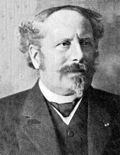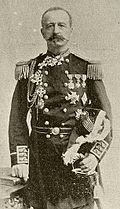This article has multiple issues. Please help improve it or discuss these issues on the talk page . (Learn how and when to remove these messages)
|
Pierson cabinet | |
|---|---|
| Cabinet of the Netherlands | |
 Meeting of the Pierson cabinet | |
| Date formed | 27 July 1897 |
| Date dissolved | 1 August 1901 (Demissionary from 28 June 1901) |
| People and organisations | |
| Head of state | Queen Wilhelmina |
| Head of government | Nicolaas Pierson |
| Head of government's history | Hendrik Goeman Borgesius (Unofficially) |
| No. of ministers | 8 |
| Ministers removed | 2 |
| Total no. of members | 10 |
| Member party | Liberal Union (LU) Independent Liberals (I) (Confidence and supply) |
| Status in legislature | Left-liberal [1] Minority government |
| History | |
| Election | 1897 election |
| Outgoing election | 1901 election |
| Legislature terms | 1897–1901 |
| Predecessor | Röell cabinet |
| Successor | Kuyper cabinet |
| Part of the Politics series |
 |
|---|
| |
The Pierson cabinet was the cabinet of the Netherlands from 27 July 1897 until 1 August 1901. The cabinet was formed by the political party Liberal Union (CU) after the election of 1897. The left-liberal [2] cabinet was a minority government in the House of Representatives but was supported by Independent Liberals for a majority. Nicolaas Pierson of the Liberal Union was Prime Minister. [3]









